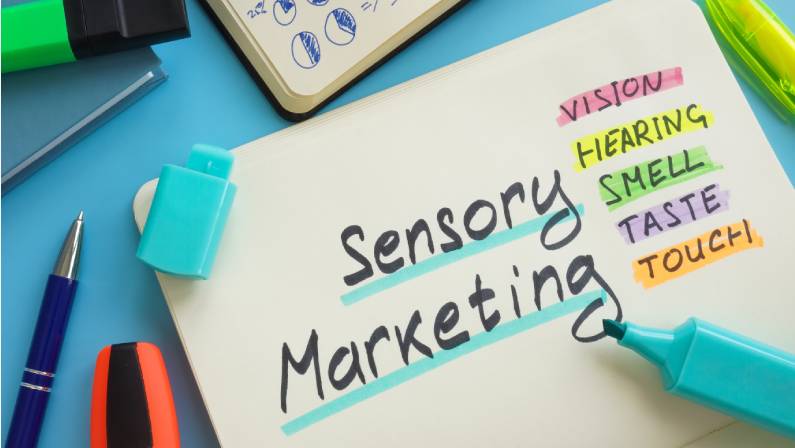Sensory marketing is an approach that appeals to the senses of your consumers. It plays a crucial role in one’s buying decisions and can further boost your brand if done correctly.
Even in today’s marketing competition, where everyone seems to be making big moves online, incorporating sensory campaigns is still a valuable effort.
This article will explain how sensory marketing works and why it is essential for your overall marketing strategy.
What is Sensory Marketing?
Sensory marketing is a vital strategy to appeal to the five senses and trigger a positive and profitable effect for your business. This approach executes a marketing campaign that targets its audience with a more meaningful and remarkable experience.
Strategic content and efforts that appeal to the senses create a lasting impact on a customer, making the brand unforgettable.
Why Is Sensory Marketing Important?
Above other digital marketing strategies, sensory branding reinforces the connection between the business and the consumer.
It appeals as an essential tool to strengthen the brand’s message and significantly impacts the customer by stimulating the senses and creating emotions in the process.
How Sensory Appeals to 5 Senses?
Appealing to the five human senses gives an unforgettable experience and customer satisfaction. Its effect is beyond the typical advertising gimmicks one sees daily. The more you engage the senses, the more response you can get from your customers, resulting in a positive effect on your sales.
Here are the five senses where sensory advertising can excel:
Taste
In today’s competitive digital advertising, it is hard to compete if your online audience cannot experience the taste of a product you offer. Images are great marketing tools. However, the food industry can not only rely on pictures that may not be that effective when attracting customers. Customers need to taste and judge it for themselves.
Free samples to give to brand advocates or influencers can make your brand’s online presence jump. Positive reviews from highly trusted leaders such as food bloggers can generate interest from your target audience.
Moreover, you can explore new flavors to offer and generate buzz from interested food enthusiasts. People are always willing to try something new, and their interest may grow if they talk about it.
LeadOrigin can create an effective marketing campaign that involves influencers who can work around a particular niche. Talk to our digital marketing experts to know how this can work for your brand.
Sight
Using the sense of sight has long been an ancient practice. Ancient Egyptians created posters on papyrus to encourage customers to go to markets.
This approach has evolved to this day, where visuals play a significant role in generating sales. By creating colorful and eye-catching images, infographics, and videos, businesses use this strategy to attract their target audience online.
Touch
Some people prefer using their sense of touch to find a particular product believable. About 75 percent of consumers prefer touching the product before making a purchase, especially for furniture or clothing. Visual images may lack the convincing power for a business to generate sales unless the customer has tried them firsthand.
An example of this is when buying a car. A client would have to book a test drive and have a good feel of how it works. Buying clothing is another typical example of appealing to the sense of touch. The customer tries on an item and sees if it fits perfectly or if another size is needed.
It also helps to give away freebies that customers can take home as a token for a shop visit.
When applying this to digital marketing, a business can call on their customers to visit their showrooms and try and test their products physically.
Smell
The sense of smell brings back memories and experiences. Although not all types of businesses can use this type of sensory marketing, using the sense of smell for some brands can effectively give them the exposure they need to generate sales.
The smell of freshly brewed coffee at a nearby coffee shop may remind customers to buy a cup for the day. Perfume lines would also insert sample strips in magazine pages to advertise.
Hear
Another practical sensory marketing approach is using the sense of hearing. Music and voices have their way of attracting customers by relaying the message through relatable and memorable sounds.
Advertisements use voiceovers, thematic music, and sound effects to explain products and services and cultivate moods.
What is Sense Branding
Sensory marketing should not be mistaken for sense branding. The latter is about appealing with a specific aim in mind.
With sensory branding, you use one or more senses to appeal to the customers and associate them with your brand. However, not all businesses can benefit from this. It is pretty tricky as it needs to fit in a particular product.
Choosing a specific method of sensory marketing is essential for compelling sense branding.
LeadOrigin can discuss with you more about sense branding and how to find the perfect sensory method for your brand.
Benefits of Sensory Advertising
Sensory advertising has been used by many companies online and offline. It holds several advantages for your business, making it one of the top strategies for marketing.
- Boosts recognition. Using senses promotes a brand and makes it known to your target.
- Improves brand recall. Customers tend to identify or associate your brand with positive emotions and good experiences.
- Strengthens brand loyalty. Customers put their trust and confidence in your brand.
- Make a good impression. A compelling and unique sensory experience leaves your audience attracted to you from the get-go.
- Creates impact. Not all customers can hear and see. Multiple sensory campaigns promote inclusiveness and accessibility to a wide variety of customers.
Sensory marketing tactics and strategies
These strategies will help you create appealing campaigns that involves the five senses.
Begin with your brand and buyer personas
Like in any marketing strategy, you have to identify and understand your brand and the audience you want to cater to. Determine your brand personality and remember how you can link it with the use of the senses.
After identifying your brand and buyer personas, think of the sensory experiences your customers may enjoy more. Knowing their culture, behaviors, and demographics is essential to understand how they will respond to each sensory marketing tactic you have in mind.
Work with design experts
Before you start your sensory campaign, you need to develop the correct branding that mirrors the message of your products and services.
A great branding strategy is a framework for all other marketing strategies you have in the pipeline.
Work with design experts who can make your vision into an excellent creative output that connects with your audience effectively.
Find your sound
Sounds play second in the highly-used sensory marketing approach. You must find the best sounds that resonate with your product or services.
Once you are able to find a distinctive sound that is uniquely yours, your brand builds an impactful recall for your customers.
Engage the limbic system
Scents ignite memories and emotions. From fragrances to cleaning products, scents can connect with the customers by associating them with things that remind them of good memories and beautiful things.
However, scents that tend to be solid and overwhelming may cause a customer to be turned off. Make sure to develop scents that are memorable yet mild for the nose.
Don’t underestimate offline experiences
While establishing an online presence helps a business reach a bigger audience, traditional and in-person marketing activities are still equally compelling today.
Aside from leveling up your website and social media platforms, balance your marketing efforts by participating in physical events, pop-up stores, and expos.
Showcasing your products and meeting your potential customers in person still go a long way in establishing a connection.
Marry Marketing Sense With Emotion
Emotions play an essential role in communicating with your customers. You can use any of the five senses and combine them with an emotional element.
Your advertising campaigns can touch the emotion by using feelings, memories, inspiring stories, and events to generate connections.
Combining the Senses
In marketing, you are not limited to a single sense only. Combine senses into your marketing campaigns. Visuals may pair up with sounds, and scents may pair with taste.
However, note that not all senses can fit your brand. It depends on your product or services and whether it works for your branding.
It is best to work with experts at LeadOrigin in marketing who can guide you in choosing the right combination of senses that work for your brand.
Sensory Marketing Examples
It is best to learn this technique from giant companies that have executed effective campaigns. These are some of the best sensory marketing examples today.
Apple
Apple thrives in the digital world as one of the leading providers of tech products.
However, Apple values the sense of touch and sight with their immersive in-store experiences and lets customers try and test their products.
Starbucks
Once you enter Starbucks, you will be greeted by the aroma of freshly ground coffee beans.
Starbucks sees that they grind their unique coffee bean inside the store to let the smell ignite a sensory reaction among customers.
While having packaged coffee grounds tends to be more cost-effective, Starbucks still chooses to grind their beans in-store to boost a unique customer experience.
McDonald’s
Who would ever forget McDonald’s iconic jingle – “Ba-da-ba-ba-ba – I’m lovin’ it,” which generates brand recall even without mentioning the brand.
McDonald’s has successfully used the sense of hearing to be one of the world’s most recognizable fast food chains.
Visa
Visa has successfully used sensory marketing to elevate customer trust and loyalty further. It took a while to perfect the unique sound customers hear upon completing an online transaction.
This unique sound conveys a message of a successful and secured online transaction. The checkout sound promotes trust and safety, making customers confident about their purchase.
How to Start Sensory Marketing
Sensory marketing may have been an old strategy used by many companies worldwide. However, only a few could execute effective sensory campaigns that appeal to their target audience.
It takes careful evaluation and a deeper understanding of your brand and customers to fully grasp what sensory marketing can do to improve your exposure.
Would you like to know how to start sensory marketing for your brand? Marketing experts at LeadOrigin know how to incorporate sensory branding with all your digital marketing efforts and traditional marketing techniques.
Book a consultation today with our experts, and let’s start using the five senses to improve your sales.







